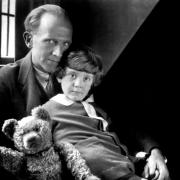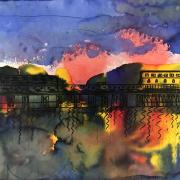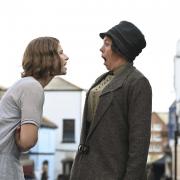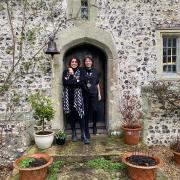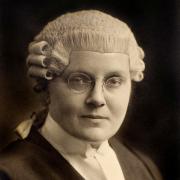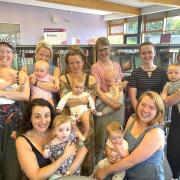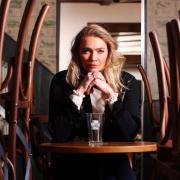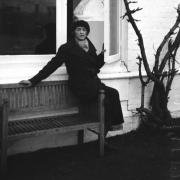How little Daisy Ashford of Lewes penned a comic classic that went on to be adapted for stage and screen

The plaque beside the door of 44 St Anne’s Crescent, Lewes, informs the world that a child named Daisy Ashford lived here, from 1889-1896. It also states that she wrote a novella entitled The Young Visiters, or Mister Salteena’s Plan, published in 1919.
Never heard of it? By 1936, it had been reprinted 19 times, admired by the likes of AA Milne and Robert Graves, would eventually be made into a stage play, a musical, a film and a feature-length TV programme, and is still in print today, in the Penguin Classics series. And the truly extraordinary thing is that, although published just after World War I, it was actually written in 1890, when Daisy was just nine years of age.
It had lain in a drawer for years, but was sent to a friend, Margaret Mackenzie, in 1917, to give her something to read while recovering from illness. She found it extremely amusing and passed it on to others, the work eventually finding its way to a reader for the publishing firm Chatto and Windus, named Frank Swinnerton, himself an author.
The Young Visiters was published in 1919, with all Daisy’s spelling mistakes and grammatical errors kept in, including the “Visiters” of the title. Its preface was penned by JM Barrie, the author of Peter Pan, at the height of his fame at the time. Initially, many readers believed it was a clever literary hoax, probably penned by Barrie himself, an idea that persisted for years. One newspaper even asked: “Is it possible that in The Young Visiters, the publishers have stumbled upon a posthumous work by Lewis Carroll?”

But it wasn’t a hoax, and quickly became something of a literary sensation, finding a huge readership both in Britain and America and garnering ecstatic reviews.
Most nine-year-old Victorian children, trying to write a story, would probably have concocted something about magical kingdoms, fairies and imps, or toys coming to life. Daisy’s The Young Visiters couldn’t be further removed from the world of childhood. It’s essentially a society novel about class, fashion, doing the decent thing, and the shy manoeuvring of Victorian courtship. These themes are woven into a tale with a surprising satirical edge about an individual named Alfred Salteena striving to become a gentleman and move up in the world. His progress is observed by two friends, Ethel Monticue and Bernard Clark, who eventually fall in love. It’s full of deliciously quirky sentences: “Bernard heaved a sigh and his eyes flashed as he beheld her and Ethel thorght to herself what a fine type of manhood he reprisented with his nice thin legs in pale broun trousers and well fitting spats and a red rose in his button hole and rarther a sporting cap which gave him a great air with its quaint check and little flaps to pull down if necesarry.”
And “I shall put some red ruge on my face said Ethel because I am very pale owing to the drains of this house.”
There’s a surprising whiff of Oscar Wilde about lines such as when Mr Salteena says: “I’m not quite a gentleman, but you would hardly notice it.”
The misspellings are delightful; who can resist this: “Well said Mr Salteena lapping up his turtle soup you have a very sumpshous house Bernard.”
Some parts are just plain funny, like Bernard showing Ethel some of his family portraits: “He moved away to the next picture. It was of a man with a fat smiley face and a red ribbon round him and a lot of medals. My great uncle Ambrose Fudge said Bernard carelessly. He looks a thourough ancester said Ethel kindly. Well he was said Bernard in a proud tone he was really the Sinister son of Queen Victoria. Not really cried Ethel in excited tones but what does that mean. Well I dont quite know said Bernard Clark it puzzles me very much but ancesters do turn quear at times.”
Laughable, too, is when Ethel rushes off to put more “ruge” on her face (rouge is mentioned many times). “She ran out of the room with a very superior run throwing out her legs behind her and her arms swinging in rithum.”
Alfred Salteena is given an introduction to the Earl of Clincham, who aids his progression up the social ladder. At the end of the story, he attends a society reception hosted by the Prince of Wales, later Edward VII, who eventually employs him. Bernard and Ethel marry, with the ceremony held at Westminster Abbey. Alfred finds love with a maid from Buckingham Palace.
So just where did nine-year old Daisy get this delightful plot from, and the droll language she used? Firstly from reading beyond her years. Barrie, in his introduction, explained; “She read everything that came her way, including, as the context amply proves, the grown-up novels of the period.”
There was an ample supply of such material in her father’s well-stocked library.
It’s obvious too that much of the dialogue and turn of phrase Daisy included had been overheard by her at some time. The house at Lewes was a busy one, with numerous visitors all probably unaware of the young girl in the corner, ear-wigging as we would now call it, when the adult conversation flowed. Some phrases she probably didn’t fully understand, such as being born “the wrong side of the blanket”(out of wedlock), but this all adds to the charm and naivety of the story. The success of the book lies in her distillation of both the literature and language of the day, with the humour deriving – often accidentally – from Daisy’s awkward mimicking of it all. As The Paris Review said, the story was “a remarkable specimen of children’s grand and unselfconscious ridiculousness.”
Daisy was born Margaret Mary Julia Ashford, in 1881, at Petersham, London. She was the eldest of three daughters of William Ashford, her father, a former War Office official, and the sixth child of his wife Emma. Both parents were Catholics and all the children largely educated at home. When Daisy was just four, already the avid reader Barrie mentioned, she dictated her first story to her father, The Life of Father McSwiney, based on a priest who was a family friend. After The Young Visiters, she wrote a few other books and short stories, plus a play called A Woman’s Crime, but inexplicably stopped writing when she was 19. She remained a storyteller though in later life, and enjoyed inventing lives for people she observed when out and about. The Father McSwiney story was published in 1983.
The family moved from St Anne’s Crescent to the Wallands Park area of Lewes in 1896, then to Bexhill in 1904. They eventually left Sussex for London, and in 1920, Daisy married James Devlin, taking up residence in Norwich, where the couple had a flower-growing business, then ran the King’s Arms Hotel, at Reepham. The couple had four children. Devlin died in 1956, Daisy remaining in Norwich for the remainder of her life and was 90 when she died in 1972.
“I really cannot remember what started me on writing,” she once wrote to her publisher. “Unless it came from a love of reading, for I remember as a very small child reading aloud to one of my step-brothers – a novel – and this possibly gave me the idea of writing one myself.”
In her advanced years, an autobiography she started went unfinished and for some reason she destroyed the text.
The original manuscript of The Young Visiters is now kept in the New York City Library. Endlessly reprinted, it was adapted almost straight away into a successful play, the musical version appearing much later in 1968. A film with Tracey Ullman and John Standing came out in 1984, then a BBC TV version was made in 2003, starring Jim Broadbent, Lyndsey Marshal and Hugh Laurie.
That’s some mileage for a story that was written in a 2d exercise book by a Lewes girl, aged just nine, back in 1890! Tempted to read it? Find it in your local bookshop or obtain it from Amazon or eBay. You’ll find yourself smiling all the way through. u




